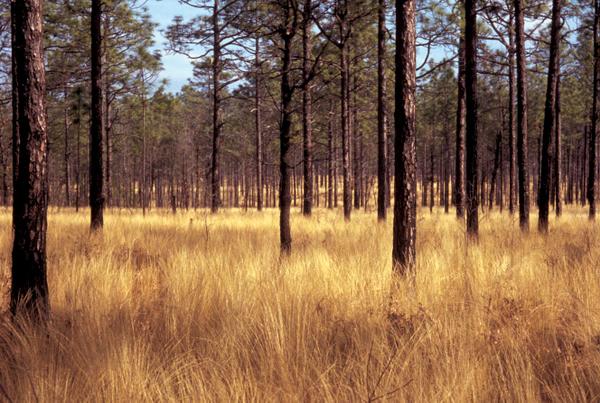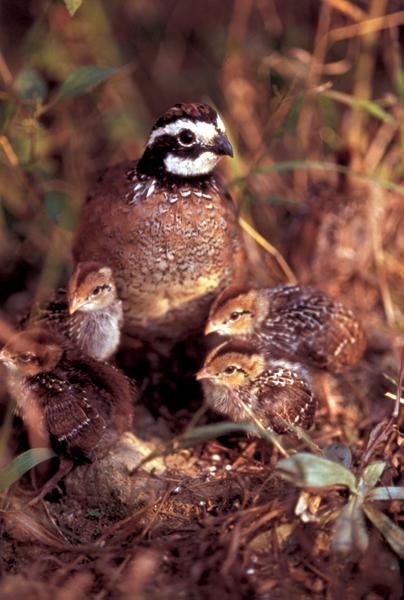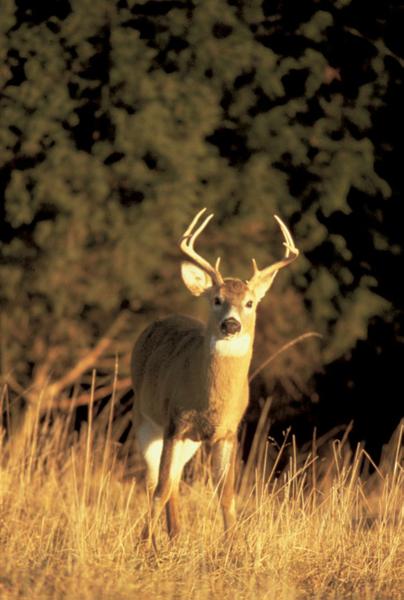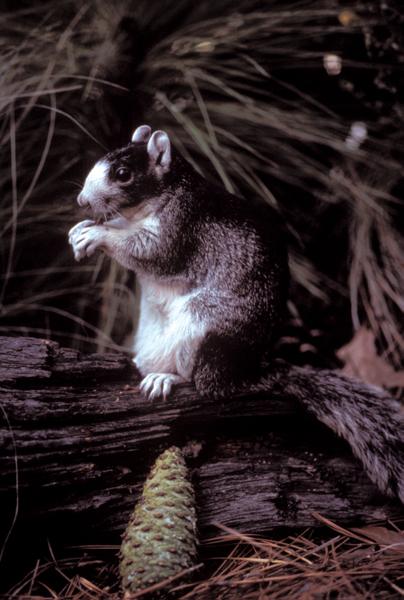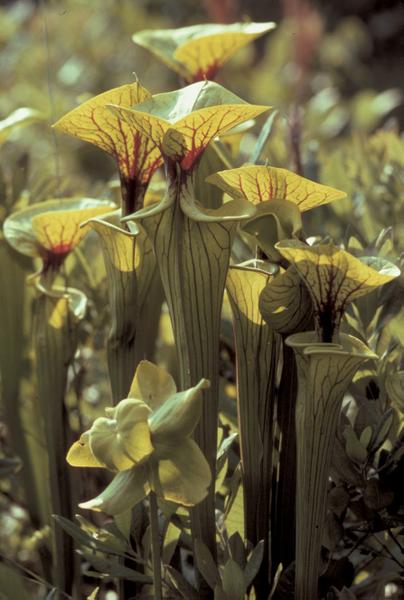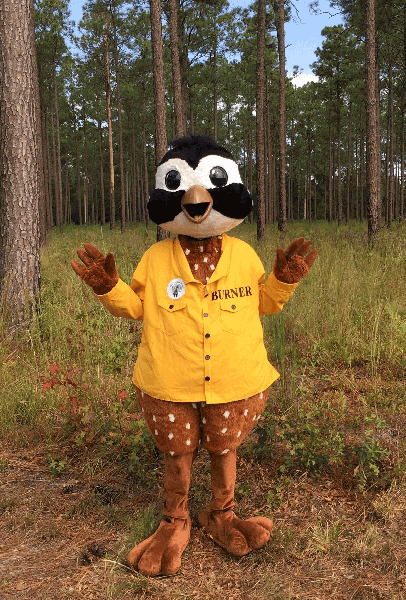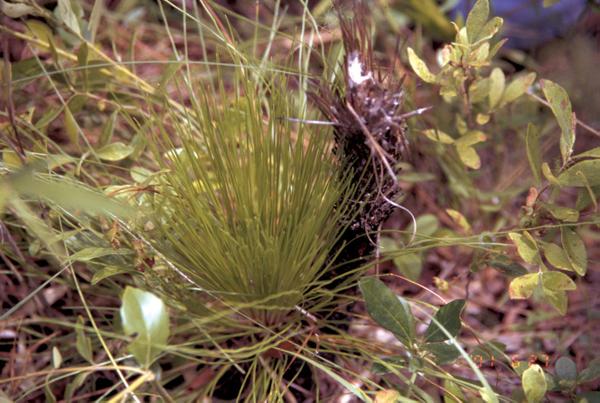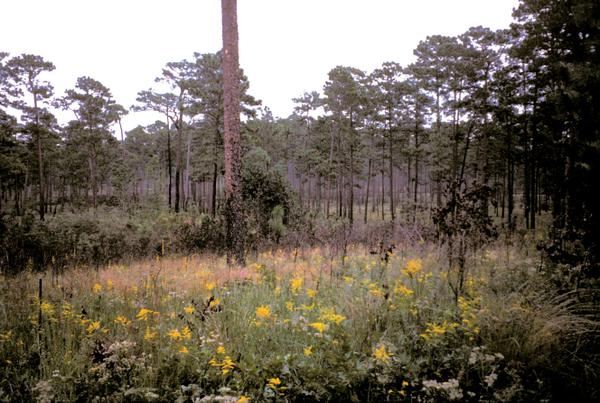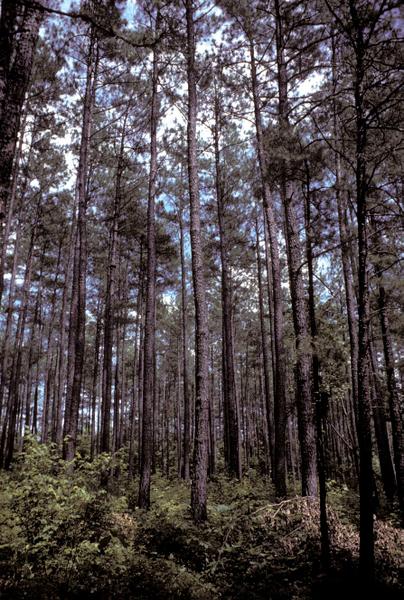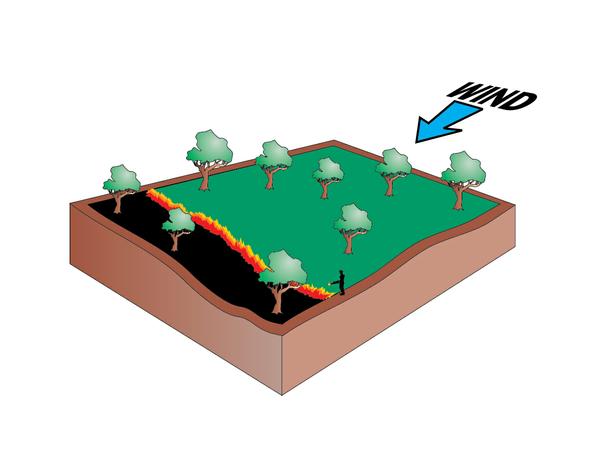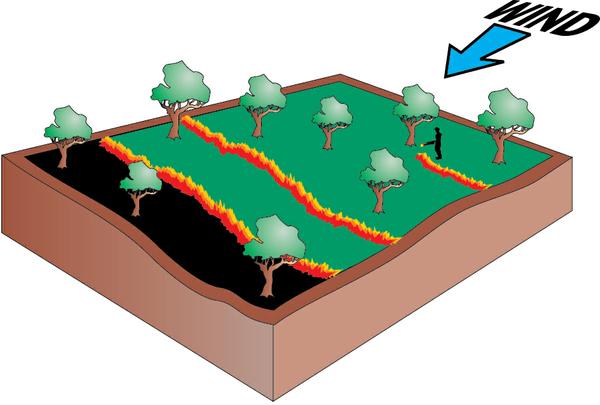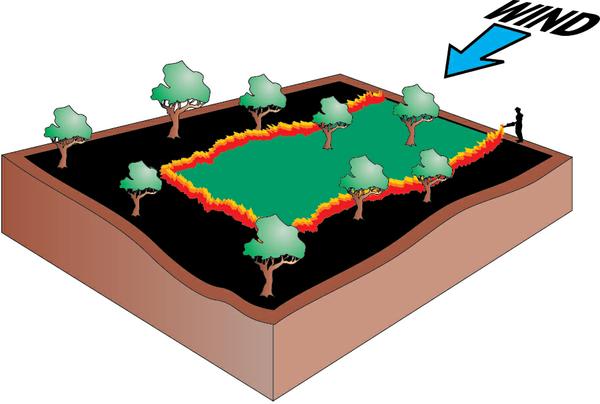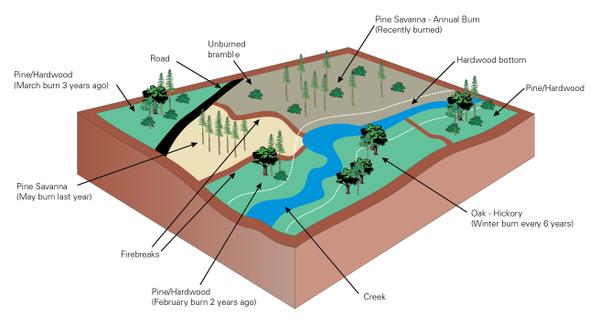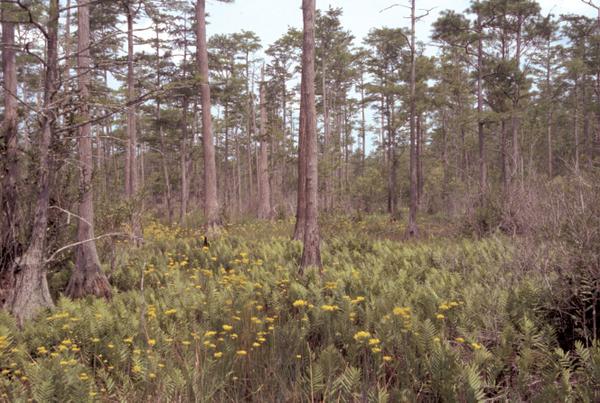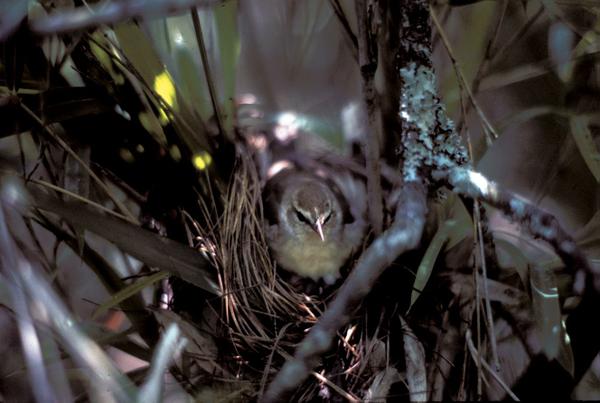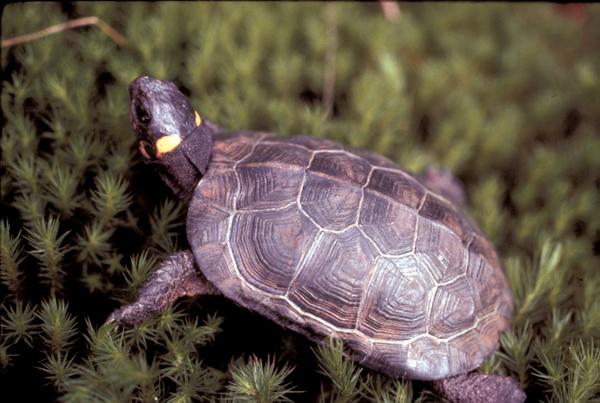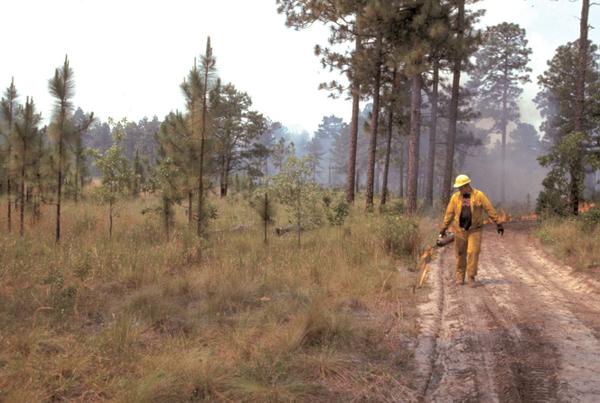Introduction
Because of its many benefits to wildlife and its relative cost efficiency, fire is a land manager’s best tool to improve wildlife habitat.
During his exploration of the southern United States in 1777, naturalist William Bartram described fields and forests greatly influenced by fire (Figure 1):
- "This plain is mostly a forest of the great long-leaved pine the earth covered with grass, interspersed with an infinite variety of herbaceous plants, and embellished with extensive savannas, always green…"
- "… riding through high open, pine forests, green lawns and flowery savannas in youthful verdure and gaity, having been lately burnt, but now overrun with a green enamelled carpet …"
For thousands of years, much of North Carolina burned every 1 to 10 years either at the hands of humans or from natural lightning ignitions. More than 10,000 years ago, Native Americans began burning southern forests and grasslands to drive game, improve grazing conditions for wildlife, clear land for farming, and improve their own safety from concealed attackers and from wildfires. European immigrants readily adopted the Indians' woodsburning practices to improve range for cattle, reduce the risk of wildfire, increase visibility of snakes and large predators, and improve access.
Importance of Fire to Wildlife
"One of the most harmful things modern man has done to birds has been his attempt to exclude fire from fire-type pine forests. Within a few years most forests choke up with brush, lose their prairie-like vegetation, and can no longer support birds dependent on periodic burning for their food supply and proper cover." (Herbert Stoddard, 1963)
Wildlife biologists such as Herbert Stoddard recognized the value of fire as a tool to conserve habitat for many wildlife species as early as the 1920s (Figure 2). Many of North Carolina's plants and animals adapt well to fire because much of the state's lands burned frequently for thousands of years. Here are some specific examples of fire's value to wildlife:
- Grasses, legumes, and other herbaceous plants germinate and flower following a fire and harbor insects and produce seeds beneficial to quail, turkeys, and songbirds. This lush growth provides cover for small mammals and young turkeys and quail (Figure 3).
- Fire burns away much of the leaf litter on the forest floor and exposes insects and seeds. Many wildlife species move into recently burned areas to feed on these newly available foods.
- Many shrubs produce more fleshy fruit 2 to 5 years after a fire than they would if they had been in an area that had not been burned.
- Young hardwoods that sprout back after a fire have more available protein and phosphorus and are more palatable to white-tailed deer and eastern cottontails than their unburned counterparts (Figure 4).
- Low ground cover and patches of shrubs are typical of frequently burned areas. This varied pattern of vegetation provides protective cover and abundant insects for some songbirds and young turkeys and quail.
Many of the plant and animal species of greatest conservation concern in the South are dependent upon or assisted by fire (Table 1). Longleaf pine forests, once occupying 90 million acres in the South, now cover only about 5 percent of their original range. Birds such as Bachman's sparrows and brown-headed nuthatches favor open pine stands with a dense grass ground cover found only in frequently burned areas. Many of the South's increasingly rare reptiles and amphibians, like the gopher tortoise, pine snake, and pine barrens treefrog, prefer forests frequently burned by fire. The long-term survival of these animals is in question if the use of prescribed fire does not persist.
| Animals | Plants |
| Red-cockaded Woodpecker | Longleaf Pine |
| Bachman's Sparrow | Table Mountain Pine |
| Brown-headed Nuthatch | Atlantic White-cedar |
| Northern Bobwhite | Wiregrass (Pineland's Threeawn) |
| Henslow's Sparrow | Bog Spicebush |
| Grasshopper Sparrow | Schweinitz's Sunflwower |
| Prairie Warbler | Michaux's Sumac |
| American Kestrel | Venus' Flytrap |
| Loggerhead Shrike | Sundew |
| Golden-winged Warbler | Pitcher Plant (Figure 6) |
| Pine Barrens Treefrog | Rough-leaved Loosestrife |
| Pine Snake | Smooth Coneflower |
| Gopher Frog | Cooley's Meadowrue |
| Fox Squirrel (Figure 5) | Chaffseed |
Does Fire Kill Wildlife?
Not usually! Animals may be temporarily displaced following a prescribed burn, but most can avoid direct harm from fire. Deer, foxes, and bobcats run; birds and bats fly; and mice, lizards, snakes, and salamanders go underground into burrows or under rocks and fallen logs as a fire approaches (Figure 7). Some animals, such as slow-moving turtles and snakes, can be killed during a wildfire or prescribed burn. However, many turtles survive fires by burrowing underground or using their shells to protect themselves. Nestlings or young birds are most vulnerable to fires. However, the overall benefit wildlife receive from habitat diversity by burning far outweighs any wildlife loss. Ironically, the absence of fire may cause greater harm to wildlife. Habitat changes resulting from fire exclusion can result in low reproduction and eventual displacement of some wildlife. Today, many wildlife species are imperiled by habitat changes resulting from too little burning.
Other Benefits of Frequent Fire
- Frequent fires help reduce the amount of leaf litter and downed wood and brush on the forest floor, which reduces the risk of severe wildfire.
- Burning reduces the thickness of leaf litter, which allows the germination and establishment of desirable plants, including longleaf pine and many herbaceous plants beneficial to wildlife.
- Burned forests contain fewer chiggers and ticks.
- Burning releases many nutrients (nitrogen is a notable exception) into the soil, thereby increasing fertility.
- Burning generally lowers soil acidity, making nitrogen-fixing legumes more abundant; legumes produce seeds eaten by quail, turkey, and songbirds and often are browsed by deer and rabbits.
- Burning can control plants that compete with commercially desirable tree species.
- Frequently burned forests attain a park-like appearance, with a high tree canopy and a sun-dappled, lush ground cover, which many people find attractive.
- Burned forests are more open and easier to walk through than unburned forests, improving access for hunters, birdwatchers, hikers, and others.
What's the Problem?
Fire protection policies implemented in the 1920s led to the transformation of forest and prairie landscapes. Southern fire-dependent plant communities, like longleaf pine forests, oak savannas, and Piedmont prairies, almost disappeared following the decline of fire, thereby causing declines in the number of animals that depended on these habitat types. Although prescribed fire is recognized as a necessary habitat management tool for forest and wildlife management, fire is used on only a small fraction of private forestlands. Because many of our native wildlife species are best adapted to habitats that experience frequent fires, burning only once in the life of a forest stand or burning less frequently than every 5 years does not maintain quality wildlife habitat. Today, prescribed burning on private lands is hampered by:
- Lack of knowledge and experience.
- Lack of equipment or personnel.
- Liability and smoke management concerns.
- Multiple ownership or small tract sizes.
- Financial limitations.
- Ignorance of prescribed fire's multiple benefits.
- Urbanization.
Some private landowners have developed informal burn associations in which they assist with burns on each other’s properties. This allows them to learn from one another, share equipment, and work cooperatively to burn larger tracts of land on neighboring properties.
Public attitudes about fire have been greatly influenced by decades of Smokey Bear's effective fire prevention messages that emphasize the destructiveness of wildfire. Although the anti-wildfire message did not extend to prescribed burning, many people are unable to distinguish between "good" and "bad" fire. Television and newspaper coverage has worsened the problem by dwelling on the sensational aspects of wildfire and doing little to educate the public on the benefits of prescribed burning. Recent efforts have attempted to promote the “good fire” concept to the public by using the #goodfire hashtag in social media and other outlets. New characters, such as "Burner "Bob," promote the benefits of prescribed fire (Figure 8).
Herbicides are increasingly used as a substitute for prescribed burning because of concern for property damage from fire. Although they help control dense brush and undesirable hardwood saplings, herbicides alone cannot provide many of the wildlife benefits that result from prescribed burning.
- Herbicides do not remove leaf litter, so they inhibit the germination of desirable grasses and forbs.
- Herbicides do not release nutrients into the soil as do most fires.
- Broad-spectrum herbicides, such as glyphosate, eliminate desirable, as well as undesirable, wildlife plants.
- Broad-spectrum herbicides may limit plant diversity for at least a few years.
However, herbicides used in combination with prescribed fire can yield desirable vegetation conditions, such as open, park-like forest stands dominated by a lush herbaceous layer, more quickly and easily than fire alone.
When to Burn
Burning of pine stands generally is not begun until the dominant trees are 15 to 20 feet tall. However, longleaf pine stands can be burned anytime after establishment except when the young trees (saplings) are between approximately one to six feet tall, when they are most vulnerable to fire (Figure 9 and Figure 10). Beneficial wildlife plants like partridge pea, beggarlice, and warm season native grasses cannot grow unless sufficient sunlight reaches the forest floor. Therefore, prescribed burning provides the greatest benefit to wildlife when conducted in open stands of timber or grasslands. Conducting a prescribed burn after a thinning operation (see Thinning Pine Stands, Woodland Owner Note-13) increases the chance that the fire will stimulate ground cover development. Burning in a forest crowded with overstory and midstory trees generally does not improve wildlife habitat because sunlight cannot reach the forest floor where beneficial plants grow (Figure 11).
In North Carolina, prescribed burning is most commonly conducted between January and March, when most trees are less active metabolically. In many cases, winter burns are necessary to safely reduce leaves and other flammable materials that accumulate during periods of fire suppression. Dormant season burns are less likely to damage canopy trees and adjacent property than burns conducted during the spring and summer. However, winter burns do not completely kill young hardwoods and they promote resprouting from the base of each plant's stem. Repeated burns conducted during the growing season eventually kill hardwood stems, allowing a diversity of grasses and wildflowers to develop. These herbaceous plants typically are more valuable to wildlife than the hardwood sprouts. One or more winter burns may be required to reduce fuel loads before conducting a growing season burn.
Dormant season and growing season burns affect wildlife habitat differently. Which type of fire you use depends upon which species of wildlife you favor (Table 2). Forests burned every 1 to 3 years and forests burned during the growing season tend to have a more open canopy with more grasses and forbs growing on the forest floor (Figure 12). Less frequently burned forests, especially those burned only in the winter, generally develop a dense understory several years following a fire (Figure 13). Within about 5 to 8 years after a prescribed burn, hardwood sprouts or saplings may become too tall to practically control with fire; in such cases, special measures (e.g., rollerchopping or herbicides) may be used along with fire to improve the quality of the forest for various wildlife.
| Species | Fire Frequency (Years) | Purpose | Concerns |
| White-tailed deer | 3-5 | Improve browse production and nutrition | Fawns |
| Northern bobwhite** | 1-3 | Improve nesting and feeding cover; increase food | Nests* |
| Wild turkey | 2-5 | Improve nesting and feeding cover; increase food | Nests |
| Grassland songbirds** | 2-3 | Improve nesting and feeding cover; increase food | Nests* |
| Shrubland songbirds | 2-5 | Improve nesting and feeding cover; increase food | Nests* |
| Eastern cottontail | 3-5 | Improve food and cover | Nests* |
| Small mammals | 1-5 | Improve food and cover | Slow-moving animals |
| Reptiles** | 1-5 | Improve habitat | Slow-moving animals |
| Amphibians | 3-50 | Improve habitat | Slow-moving animals |
| Butterflies** | 1-3 | Increase diversity of wildflowers (nectar sources) | None |
| * Leave unburned spots for nest sites and places to escape from predators. ** Animals that may prefer habitat conditions created by growing season burns. |
|||
How to Burn
Before initiating a prescribed burn, you must develop a burn plan. For the best results, your prescribed burn plan should be part of your overall forest and wildlife management plan (see Enrolling in North Carolina's Forest Stewardship Program, Woodland Owner Note-23). A consulting forester, a state wildlife agency biologist, or a state forestry agency forester can answer questions about prescribed burning or help you develop a management and burn plan. Most state forestry websites provide information on what to include in a burn plan; however, at a minimum, burn plans should include:
- The objectives and desired outcomes of the burn.
- A description of potential hazards near the burn area.
- Desired range of environmental and weather conditions at the time of the burn.
- Equipment and manpower necessary to complete the burn.
In North Carolina, you must first obtain a burn permit from the North Carolina Forest Service (NCFS). Then notify the NCFS, the local fire department, and neighbors to let them know that you will conduct a prescribed burn on your property. Before burning, you must create firebreaks around the proposed burn area. Firebreaks can be created by pulling a plow, disk, or rake behind a tractor or ATV. Firebreaks for small areas can be raked by hand or cleared of debris with leaf blowers. Roads and streams also can serve as firebreaks.
Many types of fires could be prescribed for a property, including a head fire, a backing fire, or a flanking fire. The least intense type of prescribed fire is called a backing fire (Figure 14). In a backing fire, the fire typically is ignited with a drip torch and set along the downwind side of the area to be burned. The fire then slowly creeps into the wind, burning leaves and other small matter on the forest floor. A head fire has the wind at its back, and a flanking fire is ignited in a line perpendicular to the direction of the wind. The intensity of a fire can be increased in a controlled manner by igniting parallel strips of fire about 5 to 10 yards apart (Figure 15). In this strip head fire, the downwind line of fire will briefly intensify as the new upwind ignition strip quickly moves toward it before the two meet. Remember to never completely ring an area with fire because the fire could become too intense and not leave escape pathways for wildlife (Figure 16).
You should police a recently burned stand for smoldering stumps, downed logs, or places where the fire might have crossed the fireline until no danger of fire escape or smoke damage remains. Diligence is needed to prevent fire escape. A postburn evaluation of the area should help assess whether the fire achieved the goals in your burn plan.
Wildlife Considerations
Habitat Diversity—If the primary objective of a prescribed burn is to improve wildlife habitat quality, special considerations might be made to improve conditions in and around the burned area for wildlife. If a forest has not been burned for more than 5 years, large burns might be needed to quickly restore habitat over a large area. Long absences of fire may require a dormant season burn to reduce flammable material before growing season burns can begin. Ideally, once quality ground cover is present, unburned islands of 1 to 2 acres should be left throughout larger burned areas, leaving nesting sites, alternative food sources, and protective cover for wildlife. These unburned islands preferably would contain patches of blackberry, native fruit-producing shrubs, or scattered nut-producing hardwoods like oaks and hickories. Interestingly, burning the same block every year often produces a very diverse ground cover interspersed with unburned islands because light, patchy fuels lead to spotty burns. If this is the case, protection of unburned islands may be less important.
Once areas have been burned sufficiently to restore habitat quality, prescribed fires can be conducted in smaller, 10- to 20-acre blocks. In this case, spread burning activities across your forest land in any year, leaving newly burned stands adjacent to stands that have not been burned in several years (Figure 17). This approach provides nesting, feeding, and hiding cover for a range of wildlife species and generally increases the number of animals that a forest can support.
Stumps and Dead Wood—Dead wood on the ground, also known as coarse woody debris, as well as rooted and partially-rooted stumps, provide an important source of food and shelter for mice, shrews, lizards, small snakes, salamanders, and many invertebrates. Small-diameter woody debris often is consumed during a prescribed fire, but the stumps and large fallen logs, which are most important as wildlife habitat, generally remain intact following a burn.
Standing dead trees, called snags, provide critical nesting, feeding, and resting cover for over 100 wildlife species in North Carolina, including about 40 birds (Figure 18). The manner in which fire affects snags is complex. During a prescribed burn, fire often burns into the heartwood, causing snags to fall. Although these newly downed logs are beneficial to other wildlife, they no longer are usable by cavity-nesting birds and bats. High-intensity prescribed fires may kill live trees, thereby increasing the number of snags in a forest. Additionally, less intense prescribed fires may scar the base of trees, especially hardwoods, creating an entry point for insects and disease and leading to eventual death of the tree. It is generally desirable to have at least two large snags more than 10 inches in diameter per acre, but the more snags the better. To protect snags, stumps, and large fallen logs from fire damage, rake leaves and other material away from them before a burn. Snags near the edge of the burn area can fall over firebreaks during or after a burn, so consider removing them before beginning a prescribed burn.
Burning in Upland Hardwood Stands
Typically, prescribed burning is conducted in pine-dominated forests. Many types of pines, including longleaf, Table Mountain, and pond pine, are adapted to fire and can survive relatively intense flames. However, conducting a prescribed burn in hardwood forests is not out of the question. Just as is the case in pine stands, fire has a long history in North Carolina's hardwood forests. South-facing slopes and other dry sites in the southern Appalachians likely burned at least every 10 years and often were characterized by open stands of oak with well-developed herbaceous ground cover. The fact that bison and elk, which needed the fire-maintained grass layer for grazing, once lived in western North Carolina is further evidence of frequent fire. Many of the same benefits achieved by burning pine forests may be gained by burning hardwood stands every 3 to 10 years (Figure 19). They include:
- Midstory reduction and increased ground and shrub cover.
- Removal of leaf litter, allowing valuable native grasses and forbs to grow.
- Improved quality and quantity of deer browse.
- Increased fleshy fruit and acorn production.
- Possible increase in the number and vigor of oak seedlings in the forest understory.
However, mature hardwood trees, especially species with thin bark, such as tulip-poplar, water oak, willow oak, red maple, and American beech, may be damaged or killed if a fire becomes too hot. The other oaks and most hickories are more fire resistant. You should weigh the risk of losing valuable trees against the habitat improvements associated with fire in hardwood stands.
Burning in Carolina Bays, Pocosins, and Other Southeastern Wetlands
Fire, along with saturated soils or prolonged flooding, aids in the control of vegetation in many Coastal Plain wetlands. Historically, fire that started in the surrounding uplands crept down into wetlands, especially during dry periods (Figure 20). These periodic fires once maintained vast areas of switchcane, called canebrakes, in wetland areas throughout the South. These canebrakes provided habitat for a diversity of wildlife, and remnant patches of switchcane still are used by many animal species (Figure 21). More recently, however, firebreaks typically are plowed around the edges of southern wetlands, thereby destroying the unique plant community along this boundary and preventing fire from entering the wetland. Without fire, trees and shrubs in bays and other isolated wetlands become dense and eventually the canopy closes. Herbaceous cover, which is favored by many species of amphibians and reptiles, is shaded out, and permanent drying of the wetlands may occur. It is thought that herb bogs historically burned every 2 to 8 years, whereas shrub bogs or pocosins likely were maintained by more intense and less frequent fires every 8 to 20 years. Animals like the pine barrens treefrog and the bog turtle (Figure 22) depend on the herb bog habitats maintained by fire and may become increasingly rare as the use of fire declines.
The intense fires that burn pocosins often consume the organic soil to varying depths, resulting in a variety of micro-habitats following the fire. This habitat diversity yields protective shrub cover important to black bears, while maintaining some open areas for other wildlife species. Caution should be used when burning pocosin vegetation because it can be the most explosive of all southern fuels. Always consult a professional before burning these areas.
Burning in Grasslands and Old Fields
Early explorers reported many prairie-like openings in the Piedmont of North Carolina. No such openings exist today, but experimental restoration is being tried on a few small sites. However, grassland or old fields can be maintained and enhanced by periodic burning. Benefits include:
- Reduced growth of competing brush.
- Increased palatability of grasses.
- Increased plant and insect diversity, including an increase in wildflowers.
- Increased habitat for grassland songbirds, small mammals, and butterflies, including some of our rarest species.
How to Get Help
Although relatively inexpensive and more cost effective than other forms of treatment, burning does cost money and can be a daunting task for an inexperienced landowner. A number of precautions must be taken before initiating a prescribed fire, and much planning and preparation are required to implement a burn. Burners must consider adjacent land uses; the location of nearby highways, schools, hospitals, and other potentially smoke sensitive areas; and the weather forecast. Inexperienced landowners always should seek professional assistance before conducting a burn. Financial assistance for prescribed burns, including the creation of firebreaks, may be available through programs offered by the US Department of Agriculture Natural Resources Conservation Service (NRCS) or the NCFS. Each NCFS district office has a list of local contractors who perform prescribed burns, and you can also find a list of local contractors who burn in your county on the NCFS website (Figure 23).
Become a Certified Burner
Each state has different requirements for becoming a certified burn manager and for the type of liability coverage that is provided once certified, so be sure to check with your state forestry agency for more details. In North Carolina, the North Carolina Prescribed Burn Act, passed in 1999, limits burner liability from smoke resulting from a prescribed burn, provided the proper procedures and requirements are followed. To qualify, burners must complete a certified prescribed burning program administered by the NCFS; prepare a prescribed burn plan, obtain all necessary burn permits and authorizations; notify nearby residents, businesses, and emergency response agencies of the pending burn; and conduct a prescribed burn under North Carolina Smoke Management Guidelines following the burn plan while being observed by a certified burner on-site who can verify the burn. Landowners burning 50 acres or less of their own land qualify for the reduced liability without attending a training session, provided they follow the same high standards of burning and have a burn plan completed by a certified burner. Contact the NCFS or visit their website for information on becoming a certified burner.
Additional Resource Materials
For more information, the following Woodland Owner Notes (WON) or agricultural (AG) publications are available from your local N.C. Cooperative Extension center and online from the Extension Resource Catalog.
- Enrolling in North Carolina's Forest Stewardship Program, WON-23
- Wildlife and Forest Stewardship, WON-27
- Management by Objectives: Successful Forest Planning, WON-32
- Developing Wildlife-Friendly Pine Plantations, WON-38
- Fire-Resistant Landscaping in North Carolina, AG-874
- Introduction to Prescribed Fire in Southern Ecosystems, USDA Forest Service Technical Publication, Science Update SRS-054
For more information and resources for prescribed burners, check with your state Prescribed Fire Council. In North Carolina, visit the North Carolina Prescribed Fire Council’s website.
Publication date: April 7, 2021
AG-630
N.C. Cooperative Extension prohibits discrimination and harassment regardless of age, color, disability, family and marital status, gender identity, national origin, political beliefs, race, religion, sex (including pregnancy), sexual orientation and veteran status.

